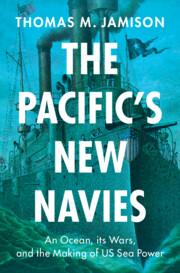Book contents
- The Pacific’s New Navies
- Military, War, and society In Modern American History
- The Pacific’s New Navies
- Copyright page
- Dedication
- Contents
- Figures and Table
- Acknowledgments
- Introduction
- 1 The Confederate “Navy to Construct”
- 2 The Pacific’s Civil War Inheritance
- 3 Pacific Naval Races and the Old Steam Navy
- 4 Pacific Wars and Their Lessons
- 5 The Californian Case for a New Navy
- 6 The US New Navy Wins a Race – Finally
- 7 The Sino-Japanese War and New “Yankees” in the Pacific
- Conclusion
- Notes
- Bibliography
- Index
1 - The Confederate “Navy to Construct”
Published online by Cambridge University Press: 05 December 2024
- The Pacific’s New Navies
- Military, War, and society In Modern American History
- The Pacific’s New Navies
- Copyright page
- Dedication
- Contents
- Figures and Table
- Acknowledgments
- Introduction
- 1 The Confederate “Navy to Construct”
- 2 The Pacific’s Civil War Inheritance
- 3 Pacific Naval Races and the Old Steam Navy
- 4 Pacific Wars and Their Lessons
- 5 The Californian Case for a New Navy
- 6 The US New Navy Wins a Race – Finally
- 7 The Sino-Japanese War and New “Yankees” in the Pacific
- Conclusion
- Notes
- Bibliography
- Index
Summary
Confederate naval building during the US Civil War (1861–1865) was a form of “self-strengthening” that had much in common with similar efforts across the Pacific World in the 1860s and 1870s. To overcome structural limitations (a lack of industrial capacity or existing warships), Confederate navy builders relied on foreign acquisitions and local innovations such as the torpedo to compete with the materially superior United States. The US Civil War was, in this sense, a vast practical experiment for small or industrially weak states confronting North Atlantic power. Beginning in the 1860s, the template set by the Confederacy – local adaptation with cheap asymmetric weapons and the overseas acquisition of qualitatively advanced systems – found numerous adopters in Pacific newly made navies. Reciprocally, many industrial producers in Europe were stimulated by demand from the Confederacy to produce novel weapons for Pacific states.
- Type
- Chapter
- Information
- The Pacific's New NaviesAn Ocean, its Wars, and the Making of US Sea Power, pp. 16 - 34Publisher: Cambridge University PressPrint publication year: 2024

